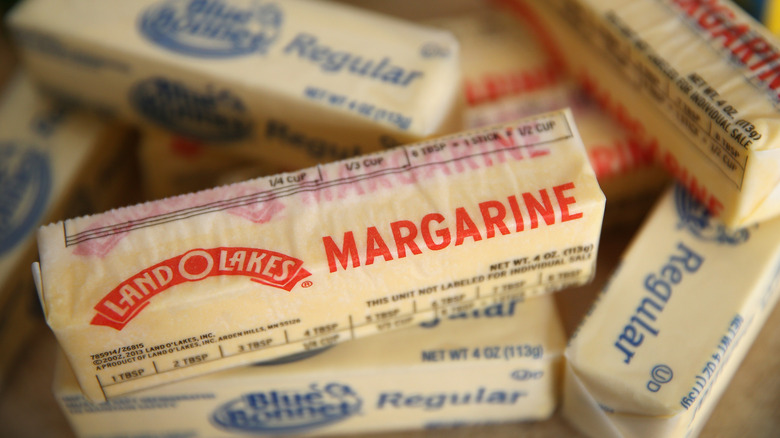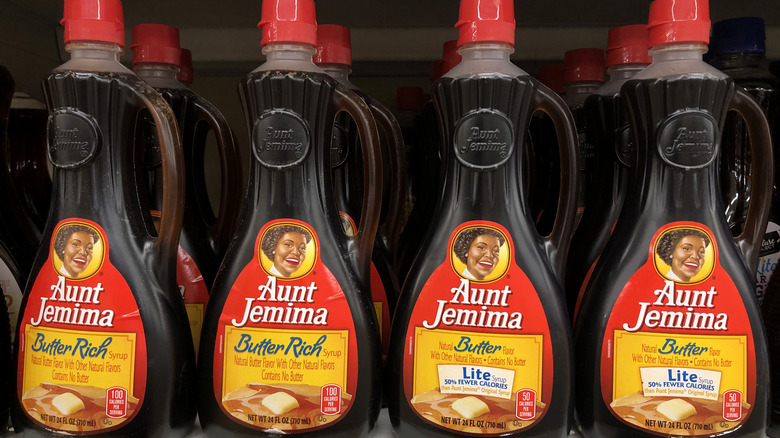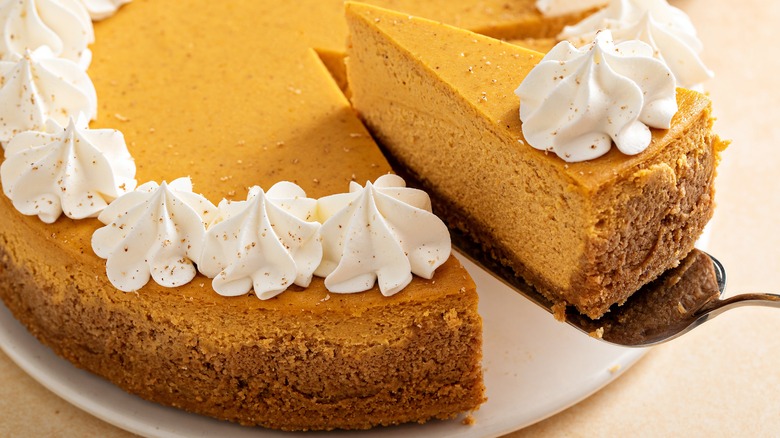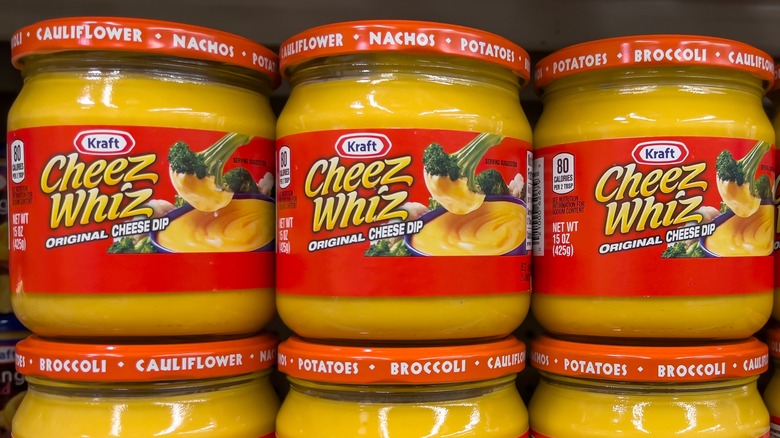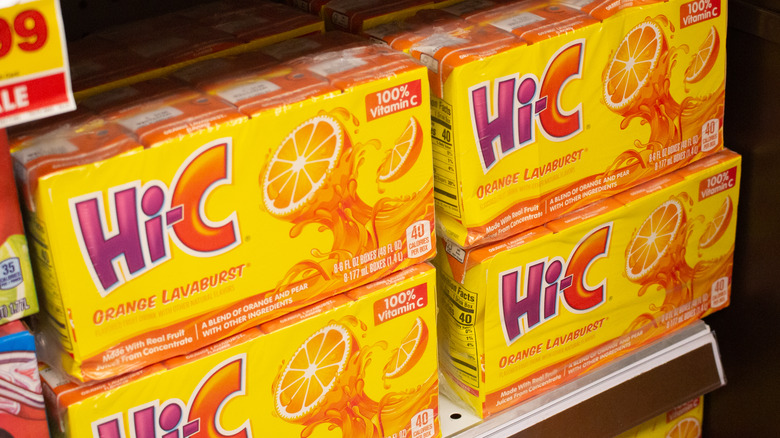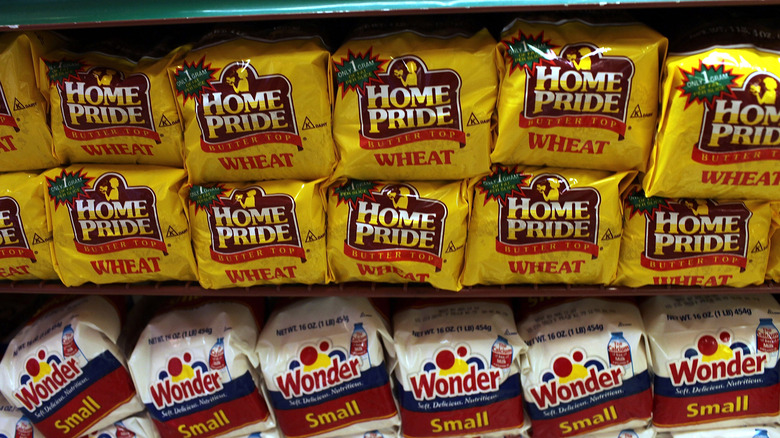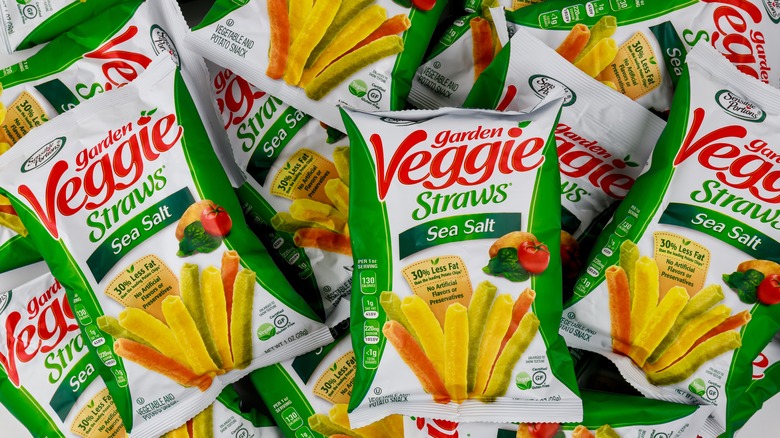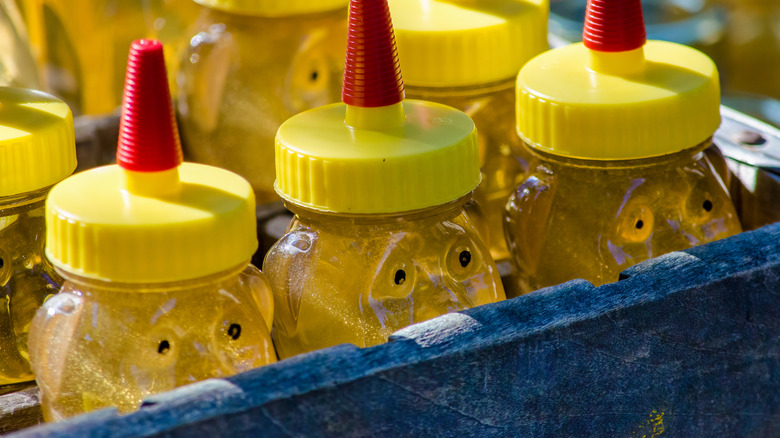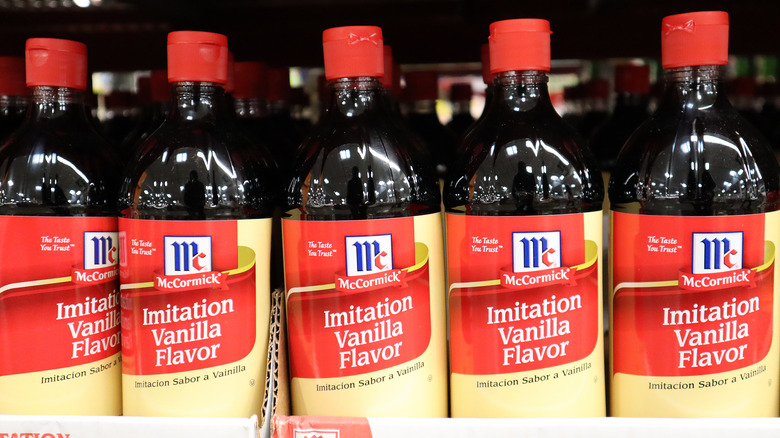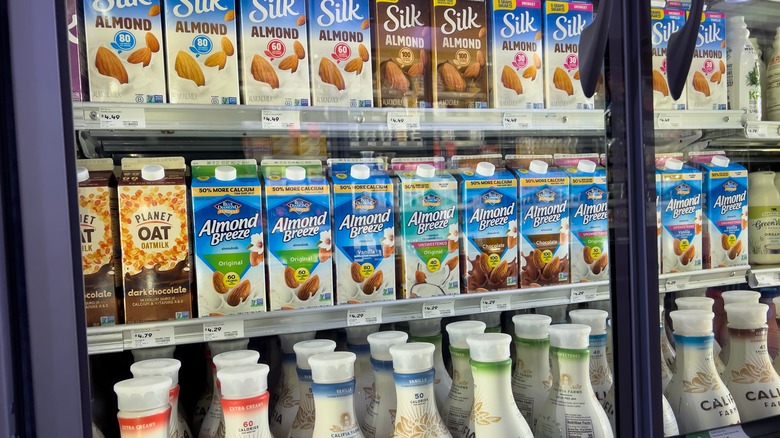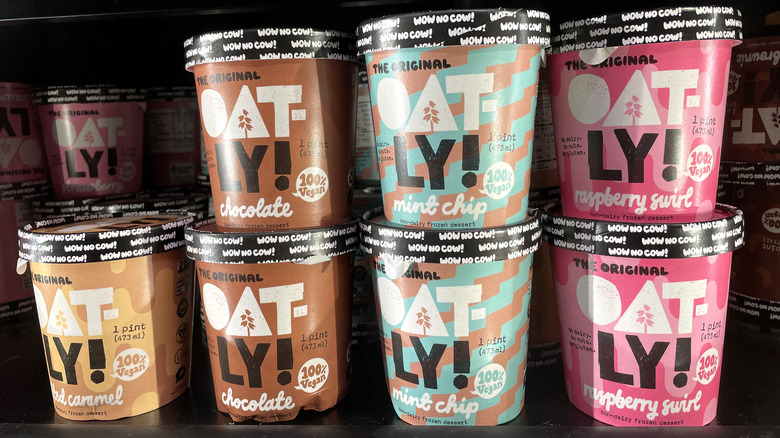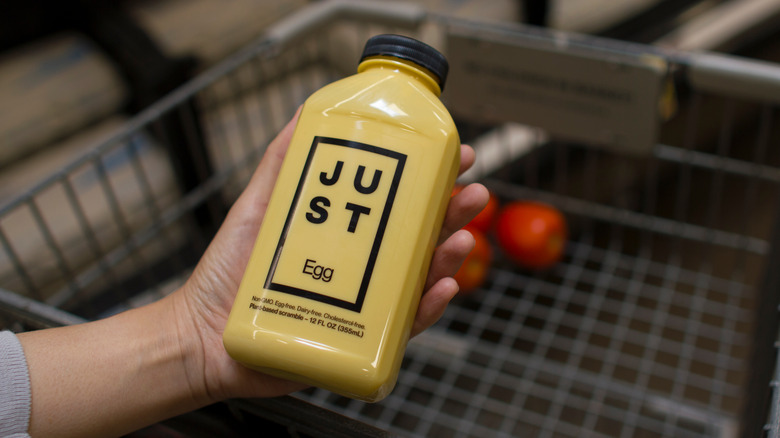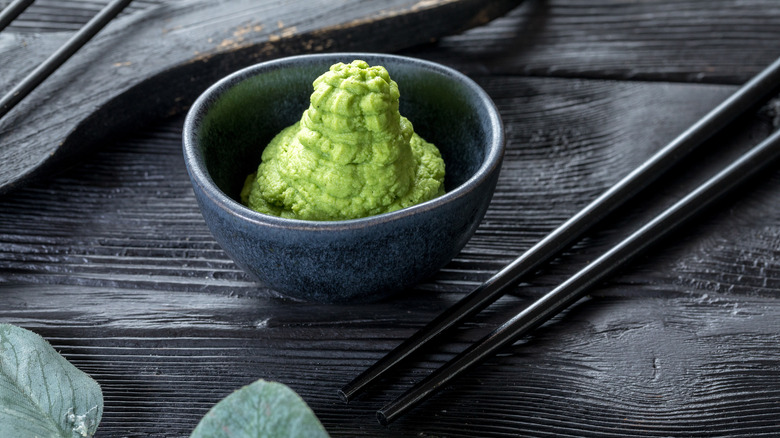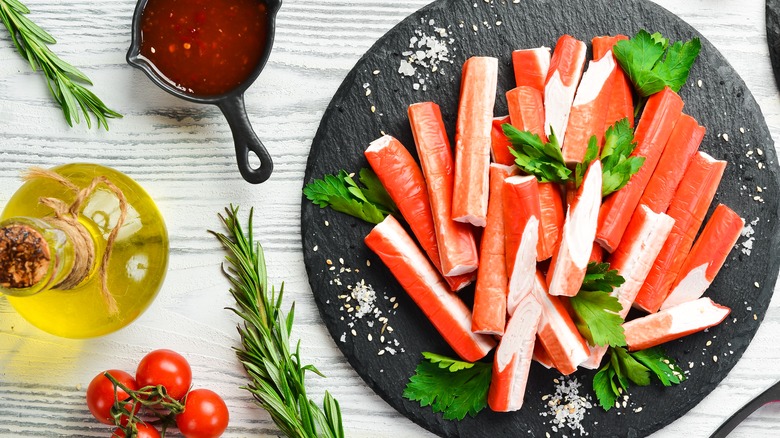9 Imitation Foods You Shouldn't Eat And 6 You Should
A well-rounded diet should be centered around food that has been minimally processed. But the world of frozen dinners, highly-processed snacks, food dyes, and artificial flavorings can be tough to navigate. It can be tricky to wade through imitation versus real foods, and which should and shouldn't make the cut.
While every diet benefits from enjoying your favorite foods with a guilt-free mindset, it's an unavoidable truth that some items should make it to your plate less often than others. In some cases, it's because imitation foods have been shown to negatively affect health more than non-imitation alternatives. In other cases, it's because the foods in question are sourced and sold in manners that are economically detrimental to local farmers or producers of the real products. Yet, there are some faux foods that aren't necessarily too unhealthy. When it comes to imitation foods, here's what you should and shouldn't be consuming.
Shouldn't: Margarine
Margarine became a popular alternative to butter in the 60s. The spread, designed for baking and melting on foods, is made from vegetable oils that have been processed to remain solid at room temperature. For years this was considered the healthier option. But with time and research, it became clear that the hydrogenation process that chemically alters vegetable oils into solid margarine products can be detrimental. Often, it caused unhealthy trans fats to be added to the equation.
And according to Cleveland Clinic, these trans fats can raise bad cholesterol levels, lower good cholesterol levels, and possibly increase the risk of heart disease. That's not exactly what you want from your morning buttery spread. For these reasons, margarine products (which, to be clear, are not real butter), should be avoided. This is particularly true of any margarine product that includes the words "hydrogenated oil" or "partially hydrogenated oil" in the ingredients list.
Shouldn't: Flavored syrup
There's no denying that maple syrup is one of those foods you shouldn't overconsume. After all, it's pretty much just sugar in a bottle. But the issue here is less about maple syrup as a whole and more about imitation maple syrup. Because, believe it or not, the vast majority of the syrups lining supermarket shelves aren't made from the sap extracted from maple trees. Rather, bottles that state simply "syrup" (or that have ingredient lists with more than a single, "pure maple syrup" ingredient listed), are more likely to be made of corn syrup and artificial colors.
The detriments in selecting a "pancake syrup" in place of real maple syrup are twofold. First, pure maple syrup derived from actual trees contains plant-derived vitamins and minerals including manganese, riboflavin, and copper. While it also may be chock-full of sugar, it's a more natural version that delivers health benefits and polyphenols, including nine that are unique to maple syrup. Second, syrups made of corn syrup and artificial flavors and colors are a more processed food that may carry health risks due to the ingredients included. Syrup as a whole should be limited to an occasional pancake or waffle breakfast. And when you do decide to indulge, make sure you're using real maple syrup, and not the fake stuff.
Shouldn't: Whipped topping
Homemade whipped cream is typically made of cream, sugar, and vanilla — pretty straightforward ingredients that you can track back to their original sources fairly easily. "Whipped topping," though? It's a little bit different. In fact, if you take a look at the ingredients on a container of Cool Whip, you'll notice common nutritional "no-nos" like highly processed hydrogenated vegetable oils, high fructose corn syrup, corn syrup, artificial flavors, and other hard-to-pronounce food additives.
Consumed in small amounts on a special occasion, like a dollop of whipped cream on top of your Thanksgiving pumpkin pie, is unlikely to be terribly detrimental to your health. But, if you're not consuming it on the regular, why not make a batch of the real stuff for those special occasions, instead? Homemade whipped cream tastes better, is easy to make, and doesn't have all the sketchy additives found in the not-so-real store-bought alternatives.
Shouldn't: Neon-colored cheese products
Sure, Kraft Singles, Cheez Whiz, and queso made from big blocks of Velveeta may all taste delicious and provide a sense of nostalgia from your childhood. However, these cheese products aren't real, 100% cheese. The bright, neon color should be a telltale sign they're packed with artificial ingredients, including colors and flavors. Plus, their ability to melt, spread, and drip is a little bit too perfect. If you've ever tried to make queso from a block of cheddar, you know it's not quite as easy as good ol' Velveeta. That's by design — neon cheese products have been engineered to resist melting to a point. But when the ideal temperature is reached, they liquify perfectly.
While American cheese and other cheese products do include cheese as part of the ingredient list, they also consist of other byproducts like additives, emulsifiers, and artificial flavors and colors. Fake cheese is also packed with salt. A serving of real cheddar cheese contains about 7% of the daily recommended intake for sodium, while a serving of American cheese contains a whopping 19%. As a whole, opt for real cheese, made and derived from animal milk, aged to perfection, and containing fewer artificial flavors and ingredients that can contribute to negative health outcomes.
Shouldn't: Fruit juices (that aren't 100% juice)
You may think you're doing something good for yourself when you grab juice from your fridge instead of a soda. But unless that juice says "100% juice" on the packaging, it might have about the same amount of sugar as that soda you're eschewing. In fact, nutritionist Robin Miller told Mashed that most fruit beverages that aren't 100% juice are high in sugar and calories, low in nutrients, and don't offer the fiber found in real fruit to help fill you up and keep you satiated. Even 100% juices contain lots of sugar, but they're redeemed by the fact that they contain more vitamins and minerals than their imposter peers.
The reality is, you're better off consuming real fruit than fruit juice in any form. This is due to the fiber content and increased levels of phytochemicals. But if you're trying to choose between 100% fruit juice and a juice that hides its real percentage on the back of the label, always go for the more legit option.
Shouldn't: Wheat bread (that isn't 100% whole wheat or whole grain)
Just as a juice that fails to tout 100% on the label, any wheat bread that lacks the same three little numbers isn't going to offer the same health-related benefits as those that do. In fact, wheat bread is simply bread made from wheat flour. Even white bread is made from wheat flour, after all. So without the differentiation of "100% whole wheat," or "100% whole grain," grabbing a loaf of wheat bread is really no different than opting for a loaf of white.
And it does make a difference. When whole wheat bread — 100% whole wheat bread, to be clear — is milled into flour, the bran and germ aren't removed. This leaves the fiber (that benefits your circulatory system and blood sugar) in these parts of the grain intact. Basic wheat bread, on the other hand, doesn't include these important parts of the grain and lacks the satisfying fiber found in 100% whole grain products.
Shouldn't: Veggie straws or chips
Veggie straws sound like the natural choice when it comes to choosing a healthy snack for yourself and your family, right? After all, veggies are good for you, so chips made from veggies should be a better option. And that's sort of true ... except when you consider the fact that a potato is a vegetable, and when you look at these chips, the first two ingredients listed are potato starch and potato flour, followed by canola oil (or other vegetable oils).
So while, yes, there are small amounts of other veggie-derived ingredients, like spinach powder, tomato paste, and beetroot powder, these are found in limited amounts. And when the nutrition facts are stacked up against other popular chips, like Lay's Classic Potato Chips, they only have 30 fewer calories and 3 fewer grams of fat per serving, but they feature 50 more milligrams of sodium. Your better bet would be to nosh on real veggies or to select a chip cut from fresh produce like sweet potatoes, beets, or even kale. These are likely to retain more of the nutritional benefits than a highly processed veggie straw.
Shouldn't: Honey
The drawbacks of consuming fake honey are similar to those of consuming fake maple syrup. What you end up eating is more likely to be made of artificially colored corn syrup than honey made by bees. Real honey that's cultivated from real bees in real beehives is one of the healthier sweeteners you can choose. In addition to sugar, honey contains antioxidants, vitamins, and minerals, and can work as an anti-inflammatory, and antibacterial agent (via Mayo Clinic).
One thing to keep in mind is that due to the practice of "honey laundering," it can be tricky to differentiate real honey from the fake stuff. All-natural honey can be expensive. So, many sellers try to "water down" the real stuff (sometimes with actual water, sometimes with other ingredients and even harmful chemicals), to sell honey at a higher return. The US government largely cracked down on this type of food fraud that was originating in China. But manufacturers have been getting around the rules by selling fraudulent honey to other countries where it's then relabeled and resold.
The result is shelves stocked with honey that may not offer any of the health benefits of real honey, while potentially delivering harmful chemicals. Your best bet when it comes to honey is to purchase locally sourced honey that has the label "True Source Certified" on the packaging. You can also tell more natural honey from more processed honey by whether or not it crystallizes in the bottle or container.
Shouldn't: Olive oil
Olive oil, particularly extra virgin olive oil, is largely considered one of the healthiest oils you can consume, thanks to its high levels of monounsaturated fats. The problem? The high demand and high cost of the product have led to high levels of food fraud. Unethical sellers looking to make higher returns are selling sub-par products. They use high-end labels (often Italian), but then fill the bottles with lower-quality oils, older oils, or oils sourced from different countries.
Your best bet? It's not to skip olive oil altogether — the real stuff is good for you. Instead, skip the international brands and choose oil from olives grown and pressed in California. Look for one with a quality seal to back up the label's claims. If you insist on purchasing oils from Italy or Greece, look for the harvest date and the "best by" date, which can help ensure you're not buying a lesser-quality oil that might be rancid.
Should: Imitation vanilla
Imitation vanilla isn't like olive oil or honey — its imitation status is shared loud and proud right there on the label. And for the most part, imitation vanilla is a perfectly acceptable (and more cost-effective) alternative to using real vanilla. First of all, vanilla is used in scant amounts as a flavoring. Think about it, even if you're whipping up a whole cake, you're unlikely to use much more than a teaspoon of vanilla. It's not a food you're turning to for significant nutritional impact. Second of all, real vanilla extract is made from an orchid and must contain at least 100 grams of vanilla bean per liter. This makes it a comparatively expensive choice when it comes to baking a few dozen vanilla cupcakes.
Fake vanilla, on the other hand, is made from vanillin, which is a naturally occurring compound in vanilla beans that can be engineered in a lab. This means it offers the same flavor as pure vanilla at a fraction of the cost. The other ingredients used in this process are benign, which ultimately makes imitation vanilla a good choice when you're looking to cut a few corners as you make your favorite desserts.
Should: Milk alternatives
This may seem like semantics, but it's an important differentiation to make. Milk is derived from animal sources like cows, goats, and sheep. Imitation milk (or various milk alternatives), is most frequently derived from plant sources like soy, oats, almonds, or coconuts. There are healthier and less healthy versions of each, and there are certainly good choices and poorer choices for individuals.
For instance, highly sweetened or flavored milk or milk alternatives (like chocolate milk or chocolate soy milk) are generally going to be less healthy choices when compared to unsweetened, unflavored options. Likewise, someone who's lactose intolerant is better off skipping cow's milk. But as a whole, plant-derived milk is a good imitation milk option for vegetarians, vegans, those cutting back on animal products, or people simply looking to expand their palates and try new things. Just be aware that every type of milk available has a slightly different flavor profile. Each is best used in different applications, so brush up on vegan-friendly milk options and make your choices wisely.
Should: Frozen dairy desserts
Frozen dairy desserts aren't the same thing as ice cream. However, they look the same, taste very similar, and are often found right next to real ice cream in the freezer section. Largely, they're a perfectly acceptable choice when it comes to picking a sweet treat. Of course, it's important to mention that ice cream nor frozen dairy desserts are going to win any top-in-health awards. But you're not buying these for their health status — you're buying them as a treat.
First, it's important to understand that ice cream is a product held to specific standards by the FDA. First, it must contain at least 10% dairy milkfat, and second, it must not contain more than 100% overrun and weigh no less than 4.5 pounds per gallon. That's a lot of semi-confusing words to say that manufacturers can't whip too much air into the ice cream base — ice cream should be creamy, and not airy, after all.
That means any ice cream-like product made from non-dairy milk or that has a too-light consistency can't be considered real ice cream. That doesn't mean it can't be made from high-quality ingredients or have a delicious, ice cream flavor. And many imitation ice cream products are actually lower in calories and fat and have been made from plant-derived milk to be enjoyed by those who are vegan or struggle with lactose intolerance. There's no reason not to enjoy them!
Should: Imitation egg products
With the popularity of Meatless Monday, the increased numbers of people following a vegan diet, and the trend to reduce consumption of animal products for health or lifestyle reasons, it's no wonder that there are lots of imitation egg products on the market. Many are simply used as binders during baking (usually requiring nothing more than water and flaxseed meal to whip up your own). But some options can be scrambled or fried and enjoyed alongside toast and fruit for breakfast.
As a whole, egg alternatives are perfectly healthy and fine to enjoy in place of the real thing. There are tradeoffs, of course. For instance, vegan eggs tend to be lower in fat, calories, and cholesterol (cholesterol is found in animal products, after all). However, they also tend to be higher in sodium and lack the same level of protein as chicken eggs. It's really a matter of personal preference and the decision to choose one over the other for dietary reasons.
Should: Wasabi
This may come as a shock, but if you've only ever eaten wasabi in the United States, chances are you've never eaten the real thing. Real wasabi is grown in Japan from a very specific wasabi plant. On the other hand, fake wasabi is typically made from a European horseradish plant, mixed with other ingredients, and dyed green to look like the real deal. The real option is rarely found outside of Japan because the plant is so expensive to grow and cultivate, requiring very specific conditions to grow and thrive.
Fake wasabi, on the other hand, is cheaper to make and package, and it keeps for a longer period of time. Its ingredients are also primarily horseradish and food dye, which ultimately aren't going to raise any eyebrows from a health-related standpoint. So go ahead and keep enjoying the "wasabi" at your local Japanese restaurant. But if you ever make it to Japan, test the real wasabi to see how it measures up to what you've grown accustomed to.
Should: Imitation crab
It should come as no surprise that imitation crab meat isn't real crab — it's another one of those foods that advertises its fake status right up front. And really, there are pros and cons to eating this meat. First and foremost, while imitation crab isn't real crab, it does incorporate real fish. But this fish is highly processed, not all that differently from how different meats are processed into hot dogs or sausages. This means that it's ultimately packed with artificial flavors, colors, and additives before it is packaged, ultimately making it a less healthy choice when compared to real crab.
Of course, not unlike the cost difference between steaks and beef hot dogs, imitation crab meat is much more affordable than real crab and has a crab-like flavor that many people love. And if there's one population that may want to reach for imitation crab every now and then, it's sushi-craving pregnant women. Because this meat is pre-cooked, sushi made of imitation crab is safe to consume while pregnant (as long as you're sure there are no other uncooked seafood products in the items you order). As long as you're selecting products made from high-quality ingredients, the occasional imitation crab dinner is unlikely to be detrimental to your overall health.

